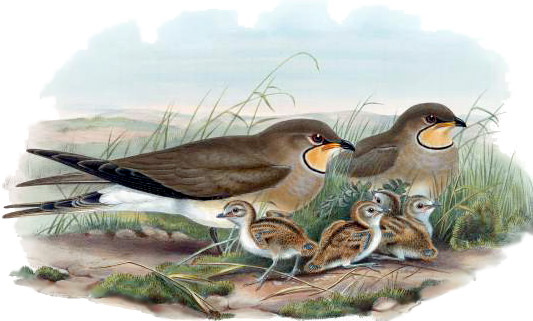| Kingdom: Animalia Phylum: Chordata Class: Aves (Birds) Order: Charadriiformes Family: Glareolidae |
Collared Pratincole (Glareola pratincola), also called Swallow Plover, is a sparse winter visitor in India. Earlier considered having two subspecies: G. pratincola pratincola and G. pratincola maldivarum. But now G. p. maldivarum has been split as a separate species Oriental Pratincole (Glareola maldivarum). Size: 23 cm Identification: The Collared Pratincole's under wings are reddish brown and it has a yellow throat with a black outline. The wings are long and pointed and it has a forked tail. The bird's legs are short and it retains the hind toe. It has large eyes, and the bill is arched and pointed with a wide gape to capture insects. The bill of a male is red at the base and usually brighter than the bill of a female. These birds have deep wing beats that makes them glide so that they can capture flying insects. The most unique feature of the Collared Pratincole is its arched bill. Distribution: Collared Pratincoles are sparse winter visitors in India and can be found in the southern parts of Europe, Iraq and south Iran in summer. It inhabits areas close to the water where there is mud and short or sparse grasses. Habits: The Collared Pratincole is insectivorous catching food in the air and on the ground. Pratincoles are gregarious and they are not territorial. They are very noisy animals that have a sharp chipping noise. During courtship, the male will spread its wings, puts its tail up, bows its head, and fly stiff-winged. The long wings allow them to spend more time in the air, and also migrate for a long distance. Food: Collared Pratincoles are fond of eating winged termites. Other insects in their diet are locusts, moths, beetles up to 25 mm, and dragonflies up to 80 mm in body length. Pratincoles also feed on small lizards and scorpions. They are known to drink water frequently. Call: a continuous 'kirri kirri' in flight. Breeding: The female lays 2 to 3 eggs that are off-white to yellowish in ground color with marked lines or blotches of black, brown, and gray, which usually looks like stones on the ground. Incubation is done by both the male and the female. While one parent provides the eggs with shade the other parent dips their belly in water to cool the skin and feathers and returns to relieve the mate that has been incubating. Status: The survival rate of this animal is very low because the environment that they live in is very hot. Since the habitat for these birds is becoming less available, the populations of these birds are dropping, mainly in Europe. Agricultural operations have contributed to the reduction of habitat. Another problem is the poor breeding success. Some conservation efforts are being made to maintain suitable breeding habitat for the birds and to add more habitat in the form of rice fields that provide shelter and food resources. |
 birding.in
birding.in
| Birds | Bird Diagram | Ornithology | Indian Sites | Bird Watching | Migration | North India | Birds of India | Haryana |
All rights reserved. Copyright © 2005-2013 Birds and birding in India. Disclaimer
website: Free Java Guide & Tutorials
